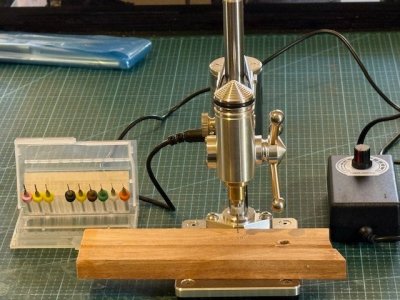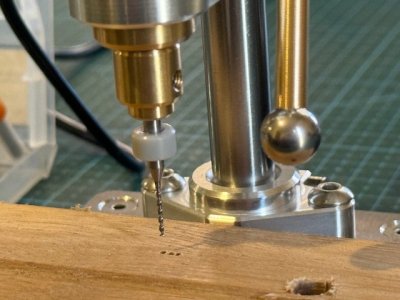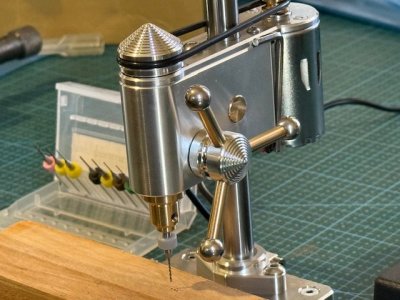I finished my first model ship build, on a desk in the TV area, with SWMBO (She Who Must Be Obeyed) patiently putting up with me crawling around on all fours looking for small dropped pieces, and small tools running while she was watching her favourite TV programs. One tool which she did not appreciate was the Dremel, with its high pitched whine.
While considering my next build, I spotted advertisements for a tiny watch repairers drill press. And I bought one. $AUD98 from AliExpress. Including postage. (see photos).
I must say that I am delighted with the Chinese made tool. It is beautifully finished, feels tight, and it is very quiet. It IS tiny. The power supply plugs in on the side of the drill which is a bit inconvenient but not a deal breaker. The power supply also houses the on-off switch and speed control.
I chose the model with a non adjustable 3.175mm (1/8") chuck, which accepts only drill bits with a 3.175mm shank. Fortunately they are available in tungsten carbide sets very inexpensively ($AUD5 per set), and they fit snugly in the chuck. My previous experience with small cheap 3 jaw chucks showed that they are not particularly accurate, and it is easy to misfit tiny drill bits into the gap between adjacent jaws rather than centrally. The ER collet model should be OK, but extra cost for that model, plus the cost of the collets, plus the fiddle of changing the collets when changing the drill bit size were factors in my choice.
So, at this time I have drilled a few experimental holes, and it seems very good. I plan to fit an X-Y axis movement table, and will probably fit a larger securing knob for height setting. Those tiny carbide drill bits a very easy to snap, but with the work securely held, and the drill press ensuring no lateral movements, breakages should be rare.
I think that this tool will be popular with model ship builders.



While considering my next build, I spotted advertisements for a tiny watch repairers drill press. And I bought one. $AUD98 from AliExpress. Including postage. (see photos).
I must say that I am delighted with the Chinese made tool. It is beautifully finished, feels tight, and it is very quiet. It IS tiny. The power supply plugs in on the side of the drill which is a bit inconvenient but not a deal breaker. The power supply also houses the on-off switch and speed control.
I chose the model with a non adjustable 3.175mm (1/8") chuck, which accepts only drill bits with a 3.175mm shank. Fortunately they are available in tungsten carbide sets very inexpensively ($AUD5 per set), and they fit snugly in the chuck. My previous experience with small cheap 3 jaw chucks showed that they are not particularly accurate, and it is easy to misfit tiny drill bits into the gap between adjacent jaws rather than centrally. The ER collet model should be OK, but extra cost for that model, plus the cost of the collets, plus the fiddle of changing the collets when changing the drill bit size were factors in my choice.
So, at this time I have drilled a few experimental holes, and it seems very good. I plan to fit an X-Y axis movement table, and will probably fit a larger securing knob for height setting. Those tiny carbide drill bits a very easy to snap, but with the work securely held, and the drill press ensuring no lateral movements, breakages should be rare.
I think that this tool will be popular with model ship builders.










 ). I ended up buying one of the Arrowmax micro drills with the drill press stand. While I really like it for getting into tight spaces as a hand-held unit, the drill press frame ... well ...leaves a lot to be desired. Not only does it sometimes tend to bind, but there is quite a bit of sideways slop. While drilling the treenail holes in the deck boards of my Oseberg, even with a guide fence, I had a heck of a time getting them a consistent distance from the edge of the board.
). I ended up buying one of the Arrowmax micro drills with the drill press stand. While I really like it for getting into tight spaces as a hand-held unit, the drill press frame ... well ...leaves a lot to be desired. Not only does it sometimes tend to bind, but there is quite a bit of sideways slop. While drilling the treenail holes in the deck boards of my Oseberg, even with a guide fence, I had a heck of a time getting them a consistent distance from the edge of the board.